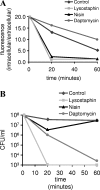Daptomycin exerts bactericidal activity without lysis of Staphylococcus aureus
- PMID: 18378708
- PMCID: PMC2415783
- DOI: 10.1128/AAC.01410-07
Daptomycin exerts bactericidal activity without lysis of Staphylococcus aureus
Abstract
The ability of daptomycin to produce bactericidal activity against Staphylococcus aureus while causing negligible cell lysis has been demonstrated using electron microscopy and the membrane integrity probes calcein and ToPro3. The formation of aberrant septa on the cell wall, suggestive of impairment of the cell division machinery, was also observed.
Figures




Similar articles
-
Correlation of daptomycin bactericidal activity and membrane depolarization in Staphylococcus aureus.Antimicrob Agents Chemother. 2003 Aug;47(8):2538-44. doi: 10.1128/AAC.47.8.2538-2544.2003. Antimicrob Agents Chemother. 2003. PMID: 12878516 Free PMC article.
-
Real-time multimodal imaging of daptomycin action on the cell wall of adherent Staphylococcus aureus.BMC Res Notes. 2025 Feb 5;18(1):54. doi: 10.1186/s13104-025-07130-5. BMC Res Notes. 2025. PMID: 39910624 Free PMC article.
-
Antimicrobial effect of Magnolia officinalis extract against Staphylococcus aureus.J Sci Food Agric. 2011 Apr;91(6):1050-6. doi: 10.1002/jsfa.4280. Epub 2011 Mar 7. J Sci Food Agric. 2011. PMID: 21384366
-
Mechanisms of resistance to daptomycin in Staphylococcus aureus.Rev Esp Quimioter. 2017 Dec;30(6):391-396. Epub 2017 Oct 25. Rev Esp Quimioter. 2017. PMID: 29082727 Review.
-
[Molecular mechanisms underlying daptomycin resistance].Sheng Wu Gong Cheng Xue Bao. 2018 Jun 25;34(6):832-838. doi: 10.13345/j.cjb.170515. Sheng Wu Gong Cheng Xue Bao. 2018. PMID: 29943529 Review. Chinese.
Cited by
-
An Adaptive Mutation in Enterococcus faecium LiaR Associated with Antimicrobial Peptide Resistance Mimics Phosphorylation and Stabilizes LiaR in an Activated State.J Mol Biol. 2016 Nov 6;428(22):4503-4519. doi: 10.1016/j.jmb.2016.09.016. Epub 2016 Sep 23. J Mol Biol. 2016. PMID: 27670715 Free PMC article.
-
The inoculum effect and band-pass bacterial response to periodic antibiotic treatment.Mol Syst Biol. 2012;8:617. doi: 10.1038/msb.2012.49. Mol Syst Biol. 2012. PMID: 23047527 Free PMC article.
-
Characterizing vancomycin-resistant Enterococcus strains with various mechanisms of daptomycin resistance developed in an in vitro pharmacokinetic/pharmacodynamic model.Antimicrob Agents Chemother. 2011 Oct;55(10):4748-54. doi: 10.1128/AAC.00084-11. Epub 2011 Jul 25. Antimicrob Agents Chemother. 2011. PMID: 21788457 Free PMC article.
-
A current perspective on daptomycin for the clinical microbiologist.Clin Microbiol Rev. 2013 Oct;26(4):759-80. doi: 10.1128/CMR.00030-13. Clin Microbiol Rev. 2013. PMID: 24092854 Free PMC article. Review.
-
Daptomycin forms a stable complex with phosphatidylglycerol for selective uptake to bacterial membrane.Elife. 2025 Jun 2;13:RP93267. doi: 10.7554/eLife.93267. Elife. 2025. PMID: 40455071 Free PMC article.
References
-
- Benson, C. A., F. Beaudette, and G. Trenholm. 1987. Comparitive in vitro activity of LY146032 a new peptolide, with vancomycin and eight other agents against Gram-positive organisms. J. Antimicrob. Chemother. 20:191-196. - PubMed
-
- English, B. K., E. M. Maryniw, A. J. Talatin, and E. M. Meals. 2005. Reduced macrophage tumor necrosis factor (TNF) secretion in response to Staphylococcus aureus (SA) isolates exposed to daptomycin compared with vancomycin or oxacillin. Abstr. Pediatric Academic Societies' Annual Meeting, Washington, DC. abstr. 507.
-
- King, A., and I. Phillips. 2001. The in vitro activity of daptomycin against 514 Gram-positive aerobic clinical isolates. J. Antimicrob. Chemother. 48:219-223. - PubMed
-
- Lakey, J. H., and M. Ptak. 1988. Fluorescence indicates a calcium-dependent interaction between the lipopeptide antibiotic LY146032 and phospholipid membranes. Biochemistry 27:4639-4645. - PubMed
MeSH terms
Substances
LinkOut - more resources
Full Text Sources
Other Literature Sources
Medical

